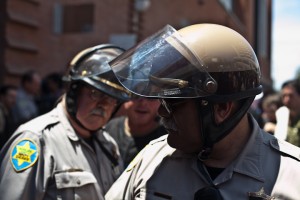Anti-immigrant forces have adeptly shaped the ongoing immigration debate into an issue of crime and punishment. Now, the pending passage of a $600 million border security bill could breathe new life into the narrative of the criminal immigrant — despite the increasing safety of our border communities.
The sentiment is familiar, if false: Crime in Mexico fuels migration, which breeds violence on the border, which must then be combated within our cities. The undocumented must be punished for stealing our jobs, stealing our services and ruining our neighborhoods. In Arizona, lawmakers like state senator Russell Pearce (who claims that his ring finger was shot off by a Latino gang member) used just that rhetoric to justify the passage of SB 1070 and other anti-immigrant laws.
The reality is far different. Not only do Mexicans and immigrants experience the worst of drug-related border violence, immigration enforcement programs have shifted their resources from combating trafficking to deporting non-criminal immigrants.
Securing the border against non-criminals
At ColorLines, Julianne Hing reports that a border security bill passed by the Senate last Friday would provide $600 million in funding for unmanned aerial drones, communications equipment and 1,500 new enforcement agents on the U.S.–Mexico border. The sum is in addition to $701 million recently approved by the House for similar militarization efforts at the border.
The Obama administration quickly affirmed its support of the bill, which was re-introduced in the House and will go before the Senate for another vote today. Department of Homeland Security (DHS) Secretary Janet Napolitano reiterated the president’s assurances that the new resources would primarily target “transnational criminal organizations” in an effort to reduce “the illicit trafficking of people, drugs, currency and weapons.”
Experts argue that this renewed emphasis on border security may encourage Republicans to cooperate in passing comprehensive immigration reform — a suggestion that some lawmakers, including Sen. John McCain (R-AZ), have been quick to endorse.
The government’s demonstrated border policing priorities don’t gel with the administration’s assurances that increases in border security will solely focus on organizing crime and trafficking. As the Immigration Policy Institute points out, federal prosecutions of smugglers and drug traffickers have gone down significantly as resources have shifted to the prosecution of non-criminal immigrants crossing the border illegally.
Policing the innocent instead of the criminal
As Elise Foley reports at the Washington Independent, newly released records show that a significant portion of those deported through the Secure Communities program — which requires local law enforcement to share fingerprints with federal authorities — had no criminal records.
That number constitutes one-fourth of deportees nationally, but the proportions are much higher county-to-county. In Maricopa county, Arizona — the home of Sheriff Joe Arpaio — 54 per cent of deportees were non-criminals, while in Travis county, Texas, the figure was 80 per cent.
Immigration advocacy groups argue that the new data defies DHS’s stated commitment to prioritizing dangerous illegal immigrants over non-criminals. “ICE has blatantly misrepresented the program by saying it focuses on high-risk illegal immigrants,” Sarahi Uribe, an organizer with National Day Laborer’s Organizers Network, told Foley.
Given ICE’s admitted lack of resources and the inhumane conditions documented in many detention centers, prioritization of non-criminal immigrants is a troubling reminder that the anti-crime rhetoric of the anti-immigrant Right is nothing more than a ruse.
U.S. border communities are safer than ever
Yet, despite the ugly picture painted by mass deportations and massively-funded border security bills, communities along the U.S.-Mexico border are actually quite safe.
As Elena Shore reports at New America Media, a new poll commissioned by the Border Network for Human Rights found that 87 per cent of people living in 10 different U.S. border towns feel safe in their communities — a finding supported by other statistics:
An FBI report obtained by the Associated Press found that the four big U.S. cities with the lowest rates of violent crime are all along the border: San Diego, Phoenix, El Paso and Austin. A U.S. Customs and Border Protection report obtained by AP also found that being a Border Patrol agent is much less dangerous than being a street cop in most cities.
No asylum for Mexicans fleeing cartel violence
The relative safety of U.S. border communities stands in stark contrast, however, to that of their Mexican neighbors. While Americans live comfortably on the north side of the border, places like Ciudad Juarez (El Paso’s seedy sister city) are wracked by cartel violence.
At the Texas Observer, Susana Hayward examines the strained relationship between the two cities: one threatened by escalating drug violence, the other a gateway to largest drug market in the world. Chronicling the stories of Mexicans affected by the drug war, Hayward reminds us that while the U.S. repeatedly reaffirms its commitment to combating drug trafficking and to keeping the border safe, it offers no recourse to the scores of Mexicans who seek refuge from the violence.
This post features links to the best independent, progressive reporting about immigration by members of The Media Consortium. It is free to reprint. Visit the Diaspora for a complete list of articles on immigration issues, or follow us on Twitter. And for the best progressive reporting on critical economy, environment, and health care issues, check out The Audit, The Mulch, and The Pulse . This is a project of The Media Consortium, a network of leading independent media outlets.




